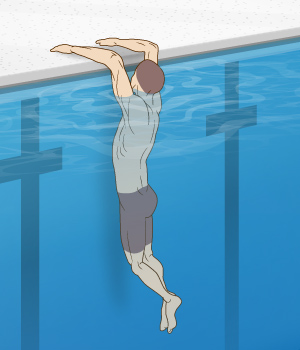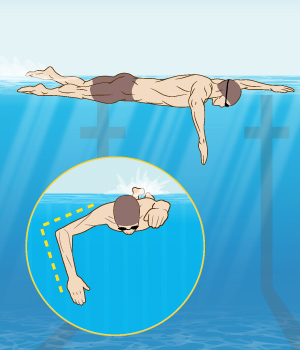How to Swim with an Early Vertical Forearm
September 11, 2014

Many swimmers pull incorrectly and as as result, are not gripping the the maximum amount of water that they can. Sometimes it can even feel like you’re swimming backwards! By working on your pull, you can improve your overall stroke and efficiency in the water. If you want to strengthen your pull, focusing on your catch is an easy way to do it. Here are some tips to teach you the “Early Vertical Forearm” (EVF) technique to improve the catch part of your stroke.
Start by finding a shallow spot in the pool along the deck. You’ll want to practice this in a pool where you can easily stand. Face the edge of the pool with your stomach pressing against the wall. Now put both your arms straight up from your shoulders like you’re trying to reach something above you. This is where you'll start your stroke, because you’ll have the most power and balance in this position.
 Now, drop low in the water until you are eye-level with the edge of the deck. With your forearm and wrist acting as a single unit, move your forearms toward the deck like you’re starting a catch. It is crucial that you keep your wrist as stiff as possible on your catch to maximize the amount of water that you grip and push past you.
Now, drop low in the water until you are eye-level with the edge of the deck. With your forearm and wrist acting as a single unit, move your forearms toward the deck like you’re starting a catch. It is crucial that you keep your wrist as stiff as possible on your catch to maximize the amount of water that you grip and push past you.
At this point, your forearms should be laying flat on the deck with your palms facing down. Your elbows should be as high as your head. If you can mimic this position, then you’ll achieve an Early Vertical Forearm at the catch point of your stroke.
EVF is a technique that applies to all of your strokes, and you should try to achieve it universally. This guide, however, will use freestyle.
Before jumping into regular freestyle, try it first while slowing down your stroke. Swim catch-up freestyle, pausing your arms in front of you for about two seconds before you begin your pull. As you start your catch, pretend that the wall is still there pressing against your body.
As soon as you begin your pull, bend your elbow while creating a stiff forearm and wrist. By bending your elbow, it should pop up relatively close to the surface. As you pull further back, your fingertips will start to point down toward the bottom of the pool.
Imagine viewing your stroke from the side profile. You’d be able to see the hand directly below the elbow. This 90 degree angle allows you to press into a power position, activating your large muscle groups. Such a strong position creates a more aggressive and efficient pull.
Once you’re feeling comfortable with your catch, try out some regular freestyle. See how your arms feel. Sometimes it’s hard to tell if you’re doing it right. If you’re unsure, think about how you feel in the water.
 If you lead your pull with your elbow, and angle your hand forward, the water will slide past your arm. This is a very ineffective, inefficient pull. Be conscious of this while you’re pulling: With an elbow-leading pull, you’ll feel the water slice right past you.
If you lead your pull with your elbow, and angle your hand forward, the water will slide past your arm. This is a very ineffective, inefficient pull. Be conscious of this while you’re pulling: With an elbow-leading pull, you’ll feel the water slice right past you.
Instead, you should bend your elbow and point your fingertips down toward the bottom of the pool. Bending your elbow will force it to go higher in the water. This will also help to point your fingertips down. Catching the water in this manner is tremendously more effective than having an angled hand/forearm.
You should feel forearm grip and press the water back. Placing your arm in this optimal position will create more resistance. This allows you to pull an increased amount of water on every stroke.
You should feel strong resistance. Try to feel the catch with the water pressing against your hand. When done properly, it will take more effort and power to pull. This is what will help propel you forward.
Keep Working on It
Now that you know what to look for, keep playing around with your catch technique. Continue to think about where your elbows and hands are, because that makes all the difference in your catch. With a little determination and practice, you’ll get the hang of it in no time!



